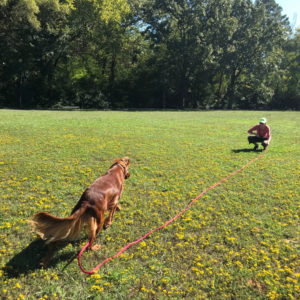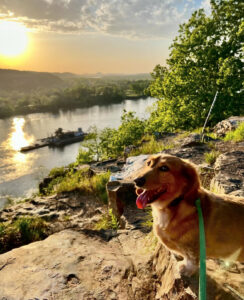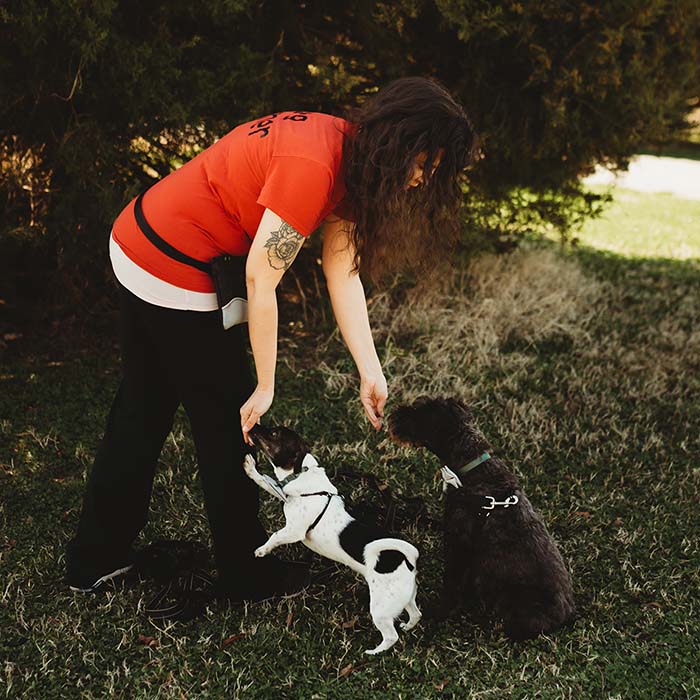Note: This is a collaboration with Philly Unleashed. Elizabeth learned how to train with Philly Unleashed before moving, but continues to work with Philly Unleashed on projects like this.
In March of 2020, when the pandemic began in the United States, information changed rapidly from day to day as the country shut down.
By May, Kim Brewer and her wife, Donna, brought home a puppy. They’d been going through the process of getting approved to foster or adopt a child when the pandemic hit, which meant their plans were put on hold. As the pandemic stretched on, they grew concerned about losing their older dog, Smokie, which would leave their three-year-old Miniature Schnauzer, Henry, without a playmate. They then found Louie, another Miniature Schnauzer. “He was not a planned pandemic puppy,” Kim shared.
Louie was born on St. Patrick’s Day and arrived at their home two months later. Training was a priority, a process they’d gone through with Henry as well. “With Henry, we went to the trainer’s house specifically,” Kim shared. “We were taking him out of his home setting and then the transportation process of actually going to someone else’s house and being at their house and their environment and the smells of other dogs. Having that period of time to adjust to that environment and then to begin to learn I think probably made it more difficult for him, especially having the kind of fear and anxiety he has generally as a breed and him specifically as a dog. And then having the situation with Louie where you came to us in the backyard and we maintained our social distance and we had our masks, even though at times it was uncomfortable with mosquitos, because, you know, central Arkansas. It was a creative solution to a problem that none of us can control. I think it helped a lot because he was already in a comfortable environment for himself so he could immediately begin to learn. And it helped his trust with you, coming into our space and hitting the ground running.”
By August, the excuse Denise and Mark LaMarra had used for five years stopping working.
They were cat people, with three felines named Tippy, Bagheera, and Mowgli. But they also had two sons, and their 12-year-old had been on a mission for some time to bring a dog into their home. “My husband and I normally work full-time outside of the house with some flexibility,” Denise explained. “Sometimes we would work from home occasionally. I would always say, ‘Well, we really can’t get a dog since we aren’t home all the time.’ Low and behold, the pandemic struck, so that was not really much of an excuse anymore. We had been sort of half-heartedly looking for a dog. .. Then, once the pandemic hit, aside from all the craziness in the world, we were accelerating our search efforts.”
They decided on an older dog at first, but with the extra time they were spending at home, they decided they could take on a puppy. They first applied through a rescue that transported dogs from the south. After a two-day trip, they’d go to a parking lot and bring their dog home. But with no pictures and minimal information about the dog available, Denise decided to try elsewhere. “I was listening to that little voice and I just thought to myself that it didn’t feel right. We had put a deposit down and everything. I asked, ‘Can we see pictures?’ We weren’t even sure what this dog was going to look like. We prefer medium to big dogs. The one picture we had, it looked like it might just be a little dog. They said, ‘We don’t have any pictures. We can’t give you any information. You just have to meet the dog in the parking lot.’ It was just one of these things where with more time that was passing I had more time to second guess myself. I thought, ‘We’ve never given a pet up in our lives, not even the guinea pigs.’ I thought, ‘This is a big commitment.’ This is a 15-year commitment and I knew I would wind up taking care of the animal primarily and I thought, ‘I need to feel 100% sure about whatever animal we did get.’ My 12-year-old was disappointed but simultaneously I was like, ‘I need to find a dog now.’”
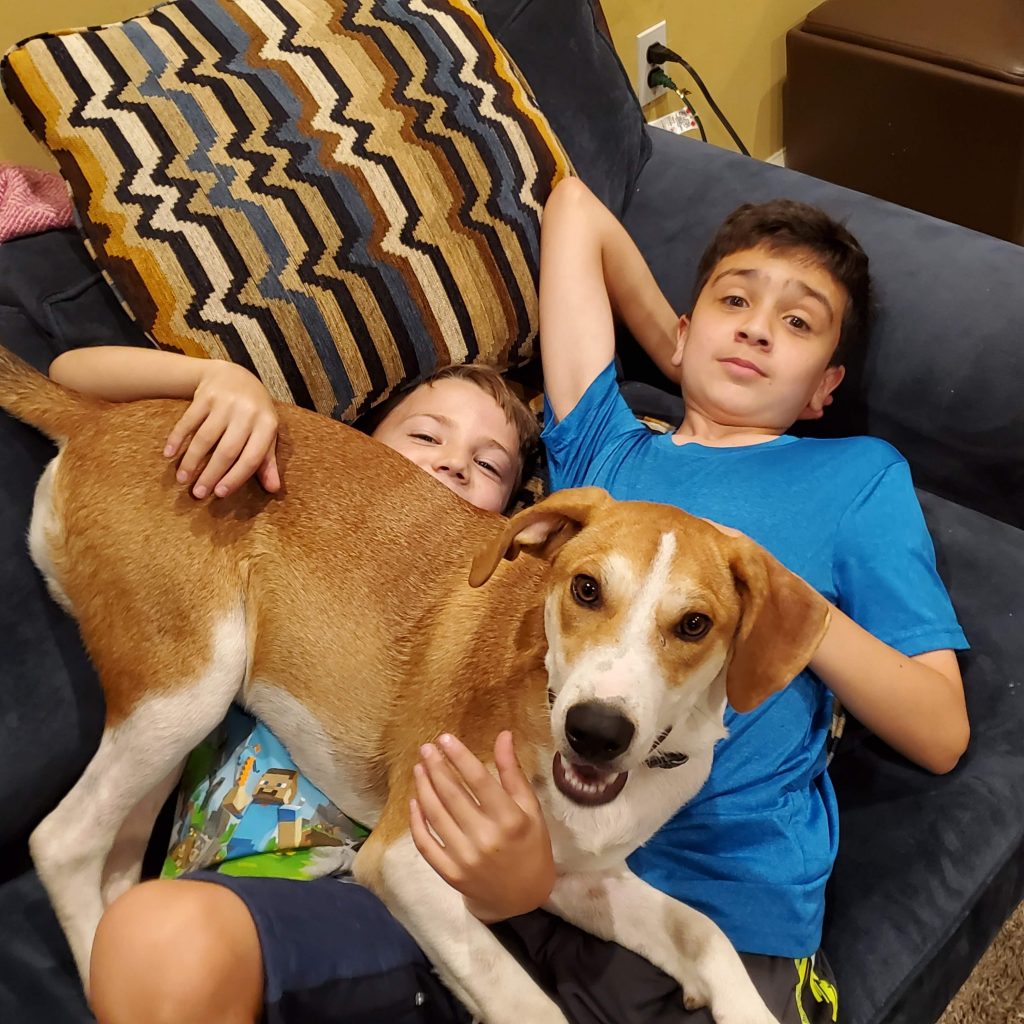
Denise thought there’d be no shortage of puppies, but the pandemic meant that a lot more people were at home as well, and rescues were running out. She finally found a puppy named Louie who’d been in a home with two children ages 9 and 12 and three cats, just like hers. She saw a video of him and spoke with his foster for an hour. “She was great, and I felt very confident he was the right dog for us,” Denise shared. “Two days after that, we picked him up.”
Plus, they had accidentally landed on a theme for their animals, which Louie’s foster pointed out, as two of their three cats were Bagheera and Mowgli. “We’re big Jungle Book fans,” Denise said. “Louie came with the name Louie. We didn’t name him. The foster mom had seen my application and she pointed that out to me. … That felt like another data point for us that he would be the right fit for us.”
By the time Louie arrived, he was seven months old. They discovered with a DNA test that he was a mixture of mostly Coon Hound, with Border Collie, Australian Shepherd, Boxer, and Collie thrown in.
They started training with Alicia Harantshuck, a certified professional dog trainer with Comfort Caring Canines and Philly Unleashed. For Alicia, the pandemic meant finding creative ways to fulfill training and socialization needs for her dog training clients.
Alicia has four dogs of her own: Vegas, an eight-year-old pitbull, Lola, a six-year-old miniature dachshund, Dillon, a five-year-old miniature dachshund, and Liberty Belle, a three-year-old coonhound. She’s trained dogs for pet therapy for the past ten years, completing over 1,000 visits with her dogs. Along the way, she realized she could increase her volunteer impact through helping others, and she’s now the president of Comfort Caring Canines, an organization that prepares and certifies therapy dogs, and teaches a variety of classes, including therapy dog prep, shy dog workshops, and trick training through Philly Unleashed. Alicia has been involved with pet therapy for almost ten years, and she became a certified dog trainer this year.
She had the idea to talk more about the dogs who were adopted during the pandemic, and that’s why this series was developed. “It came to light because many of the private clients that I was seeing were suffering from pandemic puppies,” Alicia shared. “I think some people got into situations that maybe they didn’t expect. But before we go into it too far, I do just want to take a minute and thank all of the people out there who took the time to rescue dogs during the pandemic, to give them forever homes, and are making the effort to do the best they can with these dogs under these circumstances and working with professionals in their areas. Huge shoutout to those people, first and foremost. But it was definitely the private clients that were coming over. I have a training studio at my house. Recognizing that during the pandemic, our dogs need things that unfortunately they’re not getting. Be it socialization, group training session, maybe they weren’t aware of enrichment, or how to work things in the home or crate training, and just all of those things. And it brought to light that hey, there are a lot of people in this same situation.”
The pandemic affected medical care as well, as veterinary clinics had to adapt. Dr. Marlow Ball of SOMA Animal Clinic needed to keep her staff and clients safe, all while adding a new veterinarian to the practice, Dr. Whitney Maloney, and a son to her own family, as Dr. Ball’s second child is due in early 2021.
Since there’d been so much confusion on how to prepare and handle the pandemic especially when it comes to our pets, I first interviewed Dr. Ball back in March when the lockdown began.
She explained that most veterinary clinics at the time were conserving personal protection equipment (PPE) for humans, saving gloves and masks, and postponing elective surgeries. She also recommended gathering essentials in case of quarantine or lockdown, like two to four weeks of food, medications including heartworm, flea, and tick preventatives, water, and any other basic needs. “You may need to stay in your home two weeks, so you need to have supplies that will last you and your pet through that period of that time,” she said. “Or you need to have a list of contacts of people who may be able to pick your pet up if they get sick and bring them in.”
SOMA Animal Clinic developed a curbside system that minimized direct contact with people. Dr. Ball also explained that there is no indication that dogs or cats can infect humans with COVID-19. She recommended taking precautions, like maintaining social distance while walking with the dog.
Now, there’s more information available about how cats and dogs are impacted. Cats are more susceptible than dogs to the virus, but the risk of transmission remains low between human and animal. “The chances of that are very small,” Dr. Ball shared. “I would recommend that we should treat our pets the way that we treat our children, which is that if you do not know someone well, it would be a good idea to keep pets away. If you wouldn’t let your kids run up and give a hug to someone, this would not be a good time to let your pet have close contact with other people, either.”
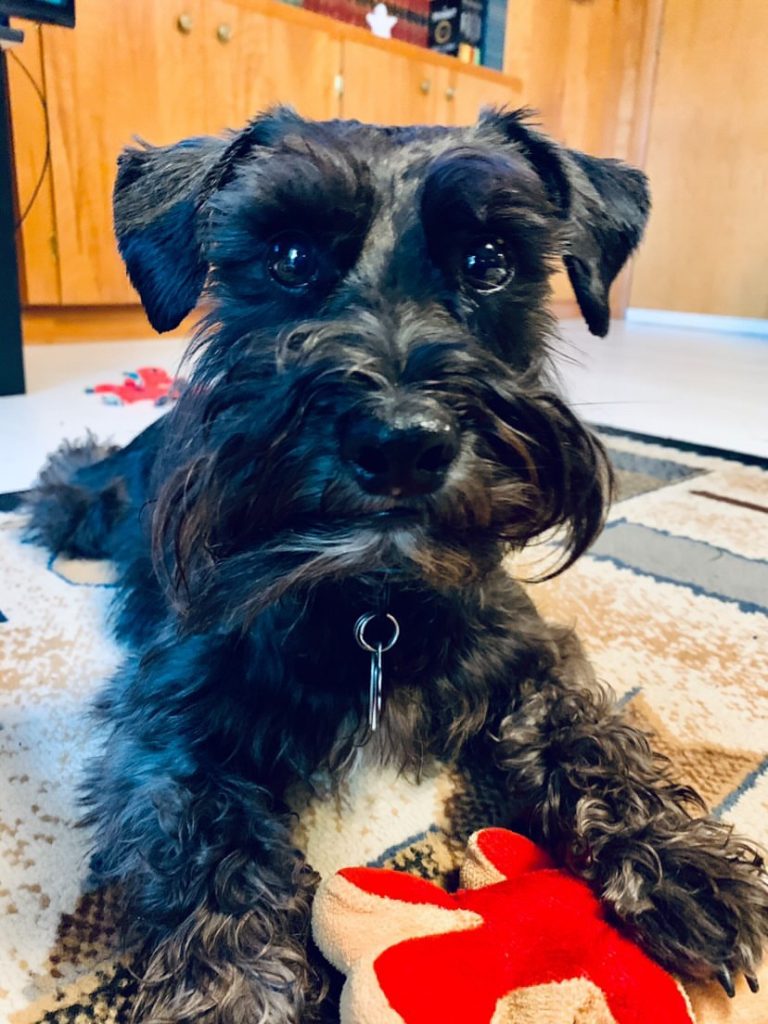
If a human in a household is sick, Dr. Ball recommends isolating from pets as well as other family members as a precaution. “The chances that we can spread this to our pets are going to be greatest when we are sick and shedding virus particles,” she explained. “If you are sick, and you’re quarantining from other people in your family, it’s a good idea to avoid close contact with your pets as well. Try to spend the majority of time in a separate room, try not to let them lick your plate or have close contact with your bodily fluids especially while you’re sick and having symptoms.”
And when out and about with our pets, Dr. Ball suggests being careful but not paranoid. “I think we just need to use common sense and try to make sure we set our pets up to be successful,” she said. “If you wouldn’t have your friends or family around a lot of strangers, I think it’s a good idea to follow the same rules as our pets. I don’t think that you should panic if your dog—as many will, dogs are feeling the social isolation as well—I don’t think you need to panic if your dog has licked a stranger or been in close contact with someone. But I think it’s easy and reasonable to bathe the pet, that may not be a bad idea, and then just monitor them for signs.”
For the foreseeable future, SOMA Animal Clinic will continue to operate with curbside services, end-of-life care for very sick patients, and special accommodations for those with reactivity or fear-based behaviors. “We are a fear-free practice, so we continue to try to utilize treats and create a positive experience,” Dr. Ball said. “There are certain things that we are asking our owners to collect and bring in. For example, a fecal sample, for most owners, grabbing a ziplock bag and bringing in a stool sample is really not that hard versus us getting a sample, which is a very rude thing for a dog during a visit. We are trying to, as usual, continue with treats and make this a positive experience. I do have some very reactive patients who do best with their owners and we are allowing situations like that. We are allowing those owners to come in. But we’ve got a large room where we are able to socially distance and good ventilation. So there are exceptions just based on the fear and reaction of each pet.”
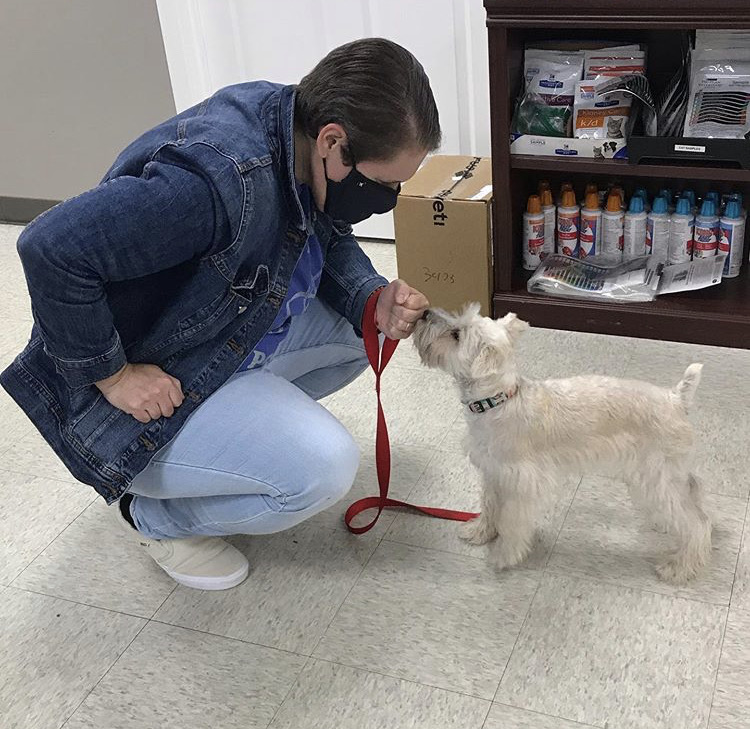
Plus, an unexpected pandemic means getting creative with training and socialization. Dr. Ball recommends doing the homework before bringing a dog home and thinking of alternatives like going to Home Depot and keeping the puppy in the cart, or running to Starbucks to get some coffee. “The more you can get them out and in the world, the better they can be when they travel to your vet,” she explained. “A lot of people are getting puppies because they’re home more and it’s been great watching a lot of local shelters getting a huge increase in adoptions. I was so worried when Little Rock Animal Village, our shelter here, closed to the public. I was worried about how all of those dogs are going to be getting homes and I was also worried that people might be rehoming pets because of economical or just hardship that people are experiencing due to job loss, and we really have not seen that happen at this time, which is very good but people are getting puppies and then it’s hard to socialize them appropriately right now because of the need to social distance. I think if you are planning to get a puppy, I think it’s important to do your homework and have a plan for what you’re going to do to socialize them.”
For those who haven’t adopted a dog yet but are thinking about it, or those who have encountered unexpected issues, there are always professionals who can help, like Alicia. “The more prepared you are to bring in a new family member, the greater chance of success you’re going to have,” Alicia said. “I’ve been very fortunate to have quite a few clients who have shown up for their training lesson, and I’m like, ‘Alright,’ going through the informational portion, where I’m gathering data on where they are in this process, and here they’ve had the dog for a week. So they’re like, ‘Okay, we got it, now what do we need to do.’ That’s been really wonderful to see people try to be very proactive. And obviously, just as willing to help those going, ‘Oh my goodness, now we have some issues.’ If you can get a head start and talk with a trainer before the dog comes home, absolutely it increases your chance of a successful transfer exponentially.”
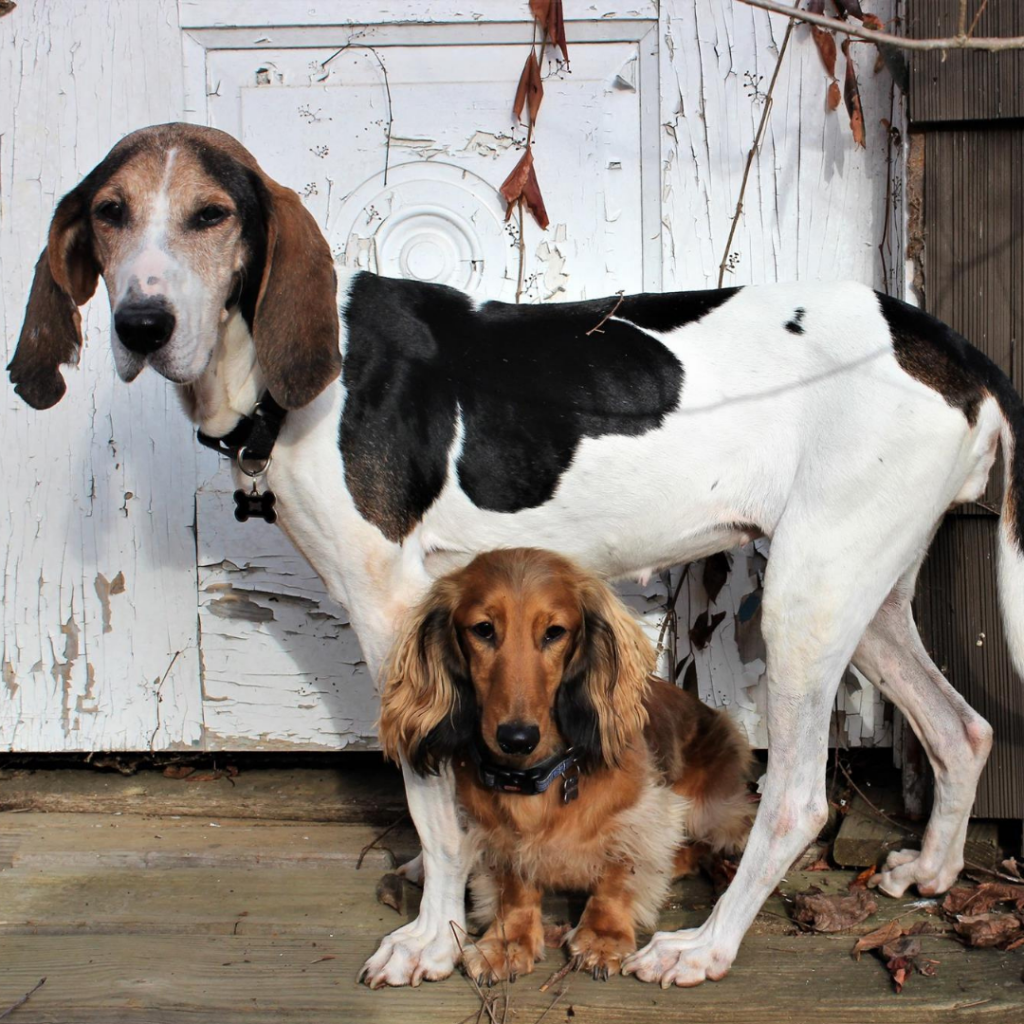
Leash manners, puppy mouth, appropriate play, jumping, counter surfing, and crate training have all been common needs that Alicia has seen.
But even trainers aren’t immune to issues. “It happens to all of us with our own dogs,” Alicia shared. “Here’s the thing. We can’t be our own mirror. We don’t see our reflection to see maybe, potentially, what are we missing in our training. Is it something with timing? Is it a body language situation? Reaching out to somebody else brings in a fresh perspective. I will speak for my community and Philly Unleashed specifically, to say we are so supportive of one another and I bring that to my clients. I feel, if I’m working with somebody, and maybe I feel like I’m missing something, then they just don’t have me as a trainer, they have my entire community of trainers. I can reach out to anyone at any time and ask for help and get suggestions and bring that back to my clients.”
Alicia has been working with Denise and Louie, who started having reactive responses on walks. Alicia had explained to them the rule of three days, three weeks, three months, which is how a dog can be expected to adjust to a new home. Denise started seeing it happen with Louie. “Three weeks to the day we brought him home, we were out for a walk,” Denise shared, “There were trash trucks and some trucks going by picking up leaves on the street and he just went completely crazy and was pulling me on the leash into the street, trying to attack these trucks, and I thought, ‘Oh boy.’ He’s 45 pounds and really muscular and even my husband was having a really hard time holding him. That was scary because I thought, ‘One of us is going to get killed or him or he’s going to pull us in front of a car.’ So that was something that we really needed to work on. We started with basics. Alicia helped us train him with the clicker and the treats. He’s a smart dog, so right away he was able to do sit, and down, and place and touch. Leave it was our big thing with the cars.”
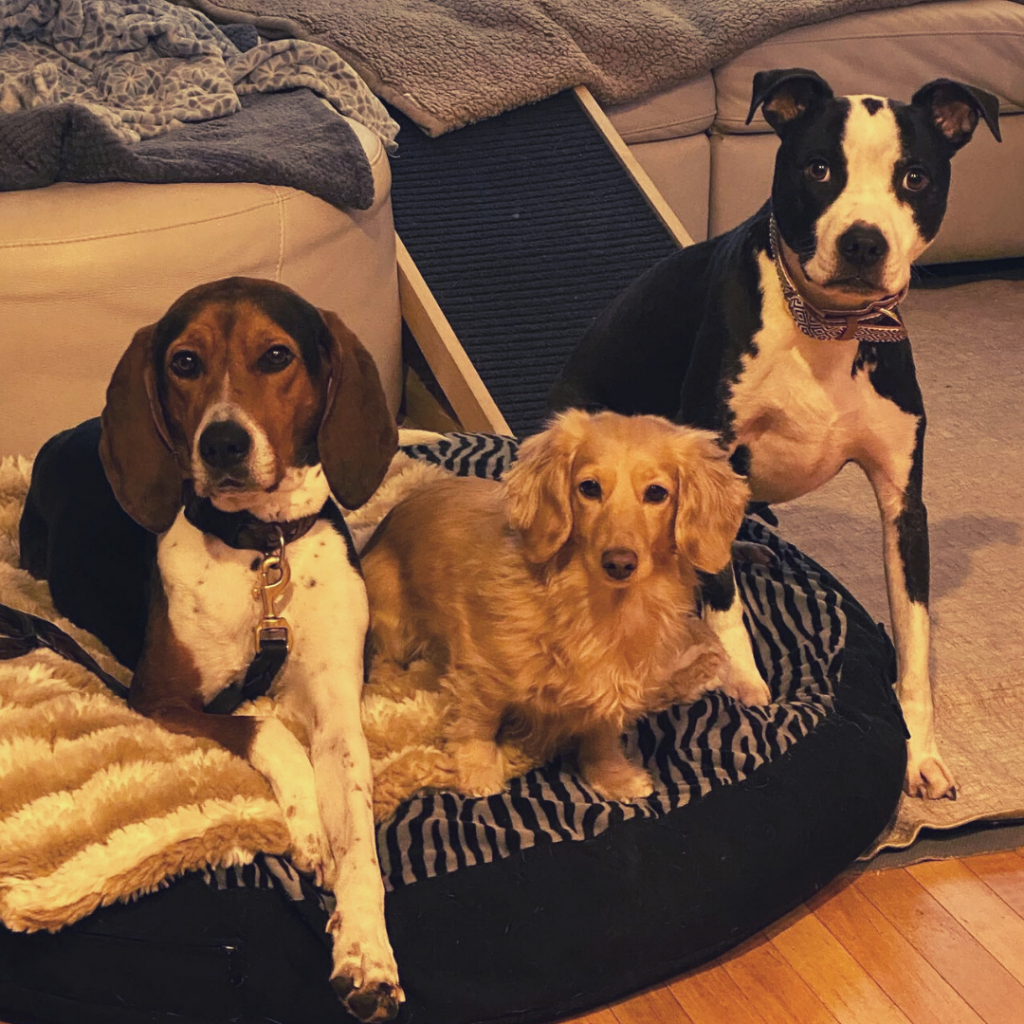
As first-time dog owners, Denise didn’t know what was normal with Louie, and Alicia was able to walk her and the rest of the family through issues as they popped up. “[We’re] first-time dog owners, so we didn’t know, okay, is this part of the normal puppy maturation process or did we get a dog that is loopy and untrainable?” Denise said. “She came over to our house and watched him with the cars and explained to us about trigger stacking. My husband and I were like, ‘Oh, that makes sense, that’s exactly why he’s okay at the beginning of the walk and not the end.’ It was just really good to have her assurance that he’s a nice dog, a good dog. We didn’t have that frame of reference. We didn’t know. She would say, ‘Not everything has to be a lesson. It’s okay if you take him out for a walk and you’re not perfectly consistent all the time.’ She gave us that permission to spend some time loving the dog and not being singularly focused on making sure he’s learning everything we’re trying to teach him.”
And being home all of the time has been a positive experience. “I don’t really have any frame of reference,” Denise explained. “It’s hard for me to imagine what it would have been like not during a pandemic. I only see positives right now because we’re home all of the time. One of the tips I got … was, whatever dog you get, make sure you put them in the crate and leave them at home by themselves for a few hours even though you’re all home. Go for a ride or go for a walk because eventually, we hope, the world will get back to normalish. I thought that was a really good tip I hadn’t thought of. That we want to make sure he can stay home by himself.”
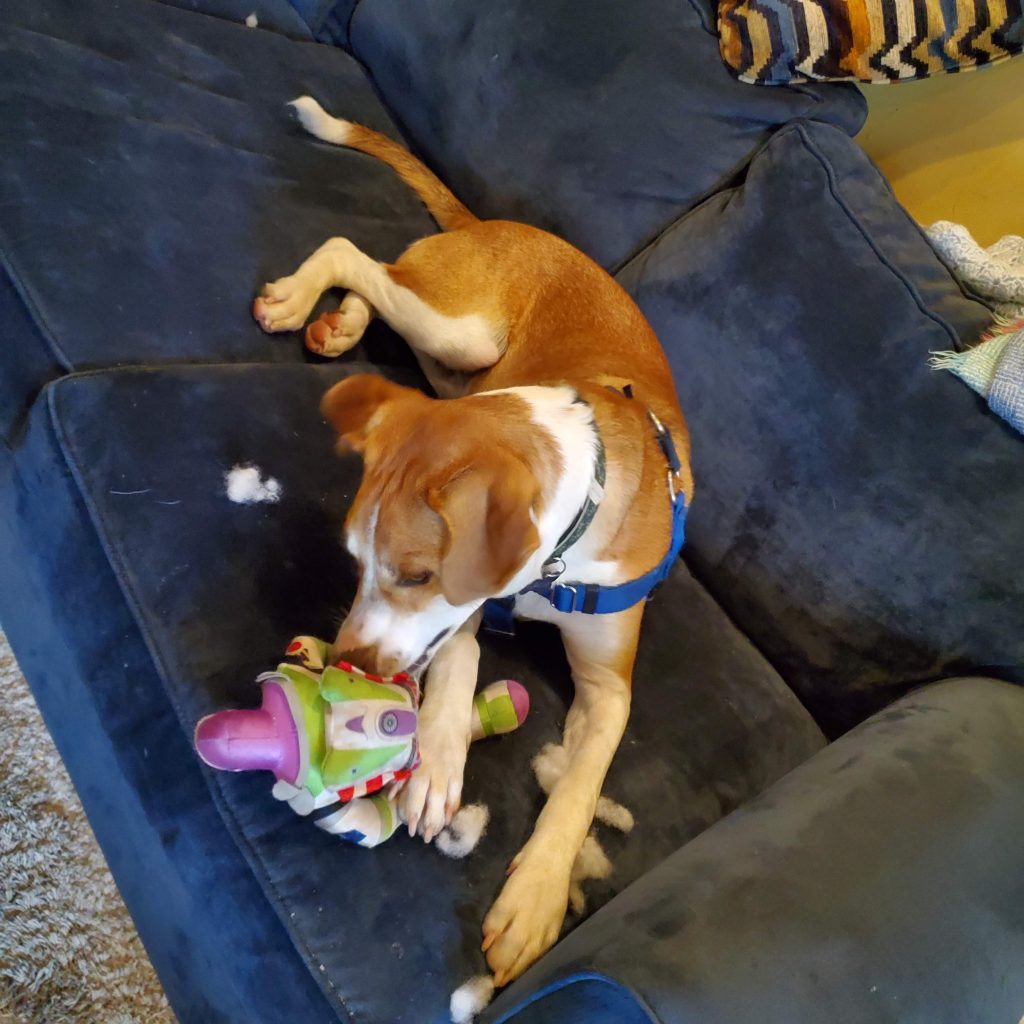
Plus, now’s the time to try things. “You most certainly have to try different things,” Denise said. “Every dog is different. The vet had said that, too. It’s kind of like when you have a kid, when you have a baby. I have two kids, and one of them loved the Bumbo and the other one hated the Bumbo. Not one thing is going to work for every dog. Definitely have patience. We’ve had him now a little over two months, and now we’re starting to get into that groove, where if we’re walking and another family member comes up to meet us, he’s wagging his tail. He’s starting to know us, and we’re getting into a better groove now. We’re over that initial hump of all of us trying to figure out what the heck is going on.”
Kim and her Louie also needed some creative problem solving with socialization. They worked with their next-door neighbor who fosters dogs. They went on more walks and encountered more people. They also adjusted some of the things they’d done with Henry, which had included letting him sleep in bed with them. Louie began crate training right away. And they made sure that they were stocked up on balls. “Get plenty of balls,” Kim advised. “As many balls as you can find and a big variety. It’s one thing at least that they both have in common with each other. For those days that they can’t go outside for the rain or whatever because they’re not creatures that enjoy being trapped inside very long, for your own sanity, make sure you have plenty of things to keep them occupied. And start practicing early with drying them off because that can be a troubling scenario. And brushing. So a lot of work with the feet and mouth area. They can get sensitive about things like that. They have their own little eccentricities. [Have] plenty of toys, plenty of different mental stimulation, and any of the little [dog puzzles] you can have. Henry is three and he loves doing [the puzzle feeder] if we put it down. Anything you can do to keep them stimulated.”
Moving forward, until there’s a widely accessible vaccination, Dr. Ball anticipates that the pandemic will be an ongoing challenge, especially as flu season approaches. “I think that once we get through to the spring, we’re going to be on the other side of this, but I don’t expect that this is going to go away in January,” Dr. Ball said. “We need to look at how we can make sure our pets are taken care of and they continue to get the services and care that they need while we also try to make safe decisions for staff and for ourselves. Most people have really embraced the curbside because it’s about keeping them safe as well. But I suspect we’re going to continue this for at least another six months or possibly longer based on projection of when a mass vaccine will be available.”
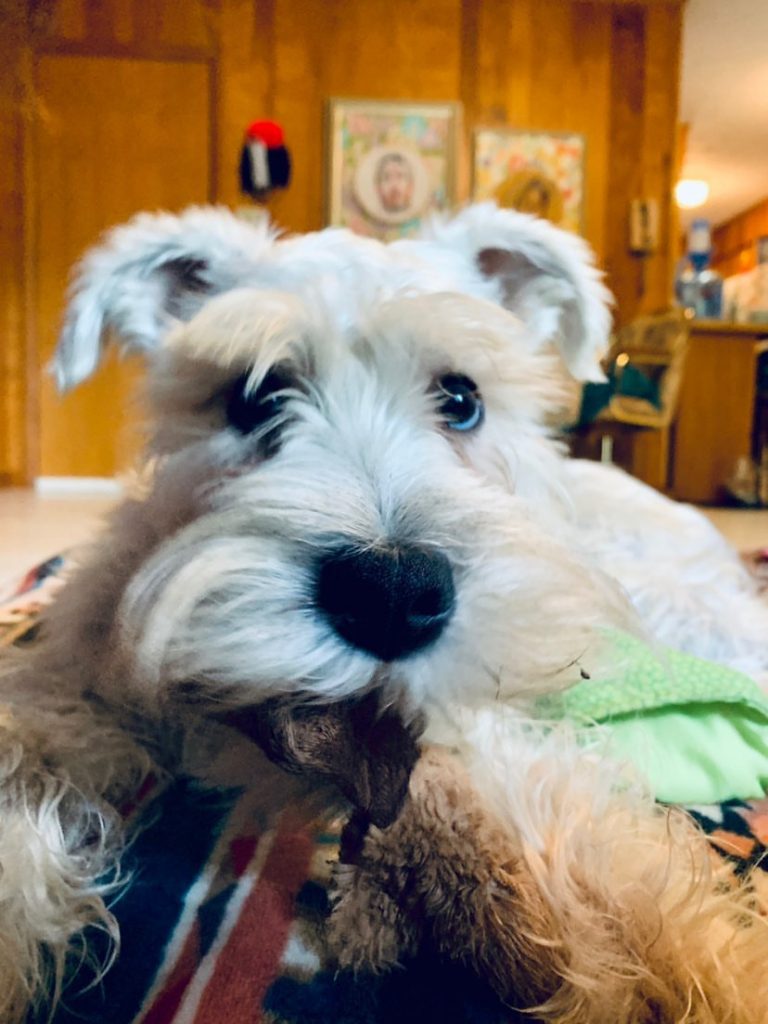
In the meantime, Alicia recommends crate training, using a kennel to redirect behaviors the way Kim and Donna did with Louie. “The first thing is, and it’s at the top of my list, because it’s the thing I hear the most, and that is crate training,” Alicia explained. “I have four dogs and I have three in their crates right now and one is out. Even when you’re home, your dog can be settling in their crate. They don’t need to be with you all of the time. If you have multiple dogs, maybe they need a break from each other, so crate rotation is a big thing. … I live what I preach. People seem to feel like well, ‘I’m home, so my dog should be out with me.’ That’s fine and true and however they want to work it. But there’s gonna come a point where you need to leave the house and you’re going to back to the office or back to whatever your normal day job is and your dog will be needing to go back into his crate so get used to it now so it doesn’t have to be so stressful for your dog. Crating during the day, on and off throughout the day is a big thing. If you want to be really precise about it, get your dog on a schedule as if you’re in the office.”
Walks and other outlets for the dog are also important, Alicia shared. Since many places aren’t offering group classes or daycares, and dogs need options to energy and use their brains, like enrichment revolving around brain burns and trick training. Trick training, Alicia explained, combines obedience, brain burns, and physical exercise, along with asking dogs to work in different positions instead of right in front of us. And there’s the added bonus of providing parlor tricks for when the pandemic is over.
She also suggested keeping pace with the dog’s learning needs. “When we get a new dog,” Alicia said, “And it’s a first-time dog for an individual or maybe it’s not, we get up awfully wrapped around training and sits and downs and you need to walk perfectly in a heel position and I don’t want you to touch something until I say it’s okay. We just expect so much out of the gate for our dogs. My biggest advice for people is to remember to go at your dog’s learning pace. Your dog is going to tell you when they’re in a learning brain and when they’re not in a learning brain. They need to learn at a pace that allows them to be successful. Manage your expectations and do not expect perfection from your dog. We are not perfect and our dogs are not perfect. … Just take your time, manage your expectations, and have fun with your dog.”


